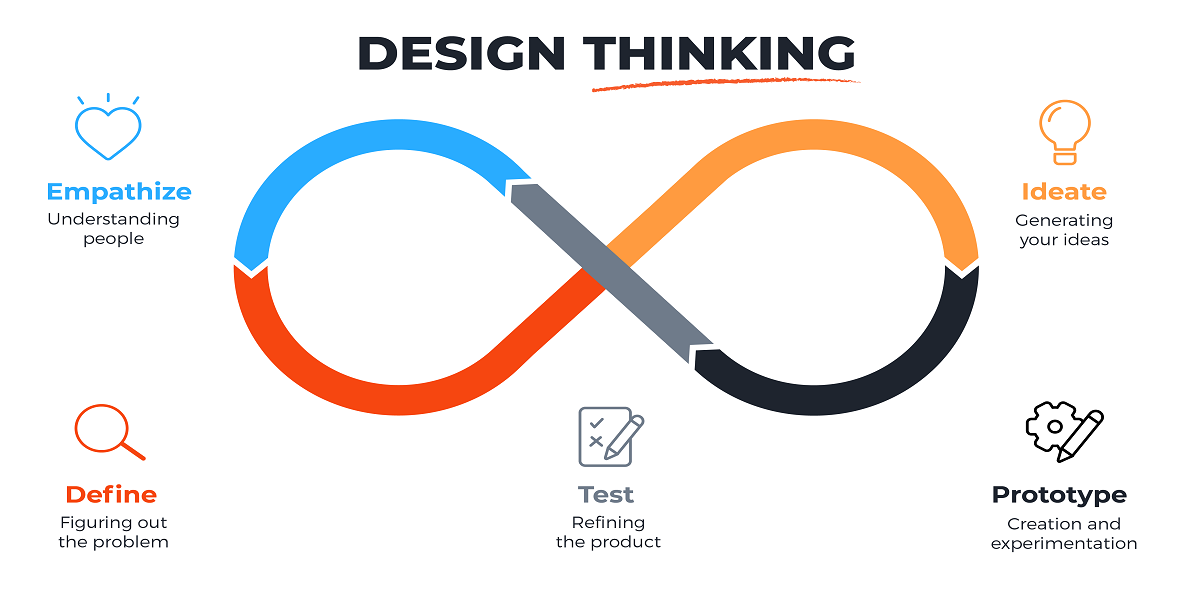
5 Stages Of Design Thinking Process
- By Charlotte Lin
- 03-05-2021
- Misc
Design thinking is an attempt to innovate by capitalizing on the collective potential of people. The application of design thinking includes collecting all sorts of ideas, be it logical, illogical, wild, or out of context, and building on each other's ideas. As a result, people often come up with some great ideas that they otherwise couldn't think of alone.
When companies set strategies, they often stumble or collect data that is of no use. This is when design thinking comes into play. It has brought many businesses a lot of happy customers and helped entrepreneurs worldwide solve problems with innovative new solutions.
Almost every innovative company in the world uses some form of design thinking. Therefore, it is essential for you whether you are a designer, a product manager, or someone interested in the topic. No matter where you go, which company you're in, they will work on innovation, and design thinking comes to the aid.
What is design thinking?
To put it simply, design thinking is a philosophy and a set of tools to help you solve the problem creatively just like escape rooms. When a company or a team is trying to solve a problem, this process makes the work easier and more structured. While many processes can be used for problem-solving, design thinking focuses on the human-centered side of creative problem-solving.
Design thinking looks at all of the creative problems solving through the lens of a human-centered approach. It primarily focuses on what you are designing and who you are designing for.
There are five different steps to the design thinking process. However, the exercises are very flexible in each of these steps. Every company, every designer does it differently. But five steps always remain the same.
Five Steps Of Designing Process
1. Empathise
This step is just about understanding the people you are trying to design the product or service for. This step is about gathering information, interviewing, creating personas, figuring out who we are making this for, their problem, and understanding what these people do. It is about empathizing with the people you are designing for.
2. Design
Now in this second step, you are taking everything you learned in step one. In defining, you are breaking it down and coming to conclusions such as what users need? Based on everything you have learned from interviewing people, we understand their problems, challenges, and insights we could take from these interviews? From empathizing with the user or customer, you will take all the inputs from step one and pick out the common problem, significant challenges, and observations. Turn that into meaningful insights.
3. Ideate
The third step in the process of design thinking is Ideate. You have mixed whatever you have learned in previous stages of empathizing and designing. Till now, you have picked out the problems and challenges. Therefore, in the third step, you come up with their solutions. You have to develop ideas, potential matches of products or services, or innovation. Try to match your solution with the insights you figure out in the previous steps. Now, coming up with ideas should be in the form of a brainstorming workshop; sharing the ideas, making notes, understanding thoughts, etc. Hence, this step is a significant step in the design thinking process.
4. Prototype
In this fourth step, prototype, you break down the ideas and plans you came up with within the previous step. Choose the ideas you want to develop. Select those ideas that you think might be worth making into something realistic. You will turn the ideas into simple, testable prototypes. These prototypes are not fully designed, not fully coded. It is essentially a facade, a dummy thing, whether that's a digital product or a physical product. It's simply something you can test with users.
5. Test your product
In the test phase, you will take your prototype based on what you created in steps 3 and 4. Now you are on the final step, where you are testing with real people. These people are selected based on what you learned from empathizing. People will use this product, and you will take feedback from them in real-time.
Have you realized yet that all these steps are interlinked with each other? One step cannot work without the other. So, you go back through the cycle. You go from testing results to the defined phase. Because once you've tested, there are going to be new insights. You will have to gather them together again and go to the ideate phase. Based on your new learning, you are coming up with new updated ideas, then back to prototype again and then again to the test phase. This is the core design thinking cycle. The important thing to understand here is that these 5 steps are a zoomed-out map of how a design thinking process works.
Why do we need to design thinking?
Design thinking requires empathy, and the world can do wonders with it. This is reaching out on trying to understand another person's perspective. It also engenders a sense of compassion for other human beings. A good thing about the process of design thinking is that it is applied learning, not just dry learning that is out of context. It just doesn't talk about maths & physics and learning these book problems, but we can apply it to the actual design we are creating. It connects the dots in your brain, talking the neurons, crossing those synapses, and strengthening all that learning.
Design thinking can undoubtedly help with learning because design problems are exciting and unique. There are no clear solutions, not one right solution in design, nor one right way to frame the issue. Therefore, it teaches people to deal with ambiguity. In this, the notion of knowing how to measure what's good. That is something we encounter in the real world all the time.
Design thinking is usually regarded as the central point of problem-solving. It did not count wholly on emotion and intuition, nor does it relies solely on analysis and science, but it uses a mixture of both. Perhaps the most significant benefits of design thinking are that it puts human first.
For the user, this brings better, valuable products that solve their problem and improve their lives. For businesses, this means happy customers and more money in the bank—a win-win solution for both sides.
Recent blog
.jpg)
Why Specialized Ecommerce SEO Companies Scale Growth Faster?
SEO | 12-09-2025.jpg)
AI vs. Human Intelligence: Can Machines Really Think?
Artificial Intelligence | 12-09-2025




